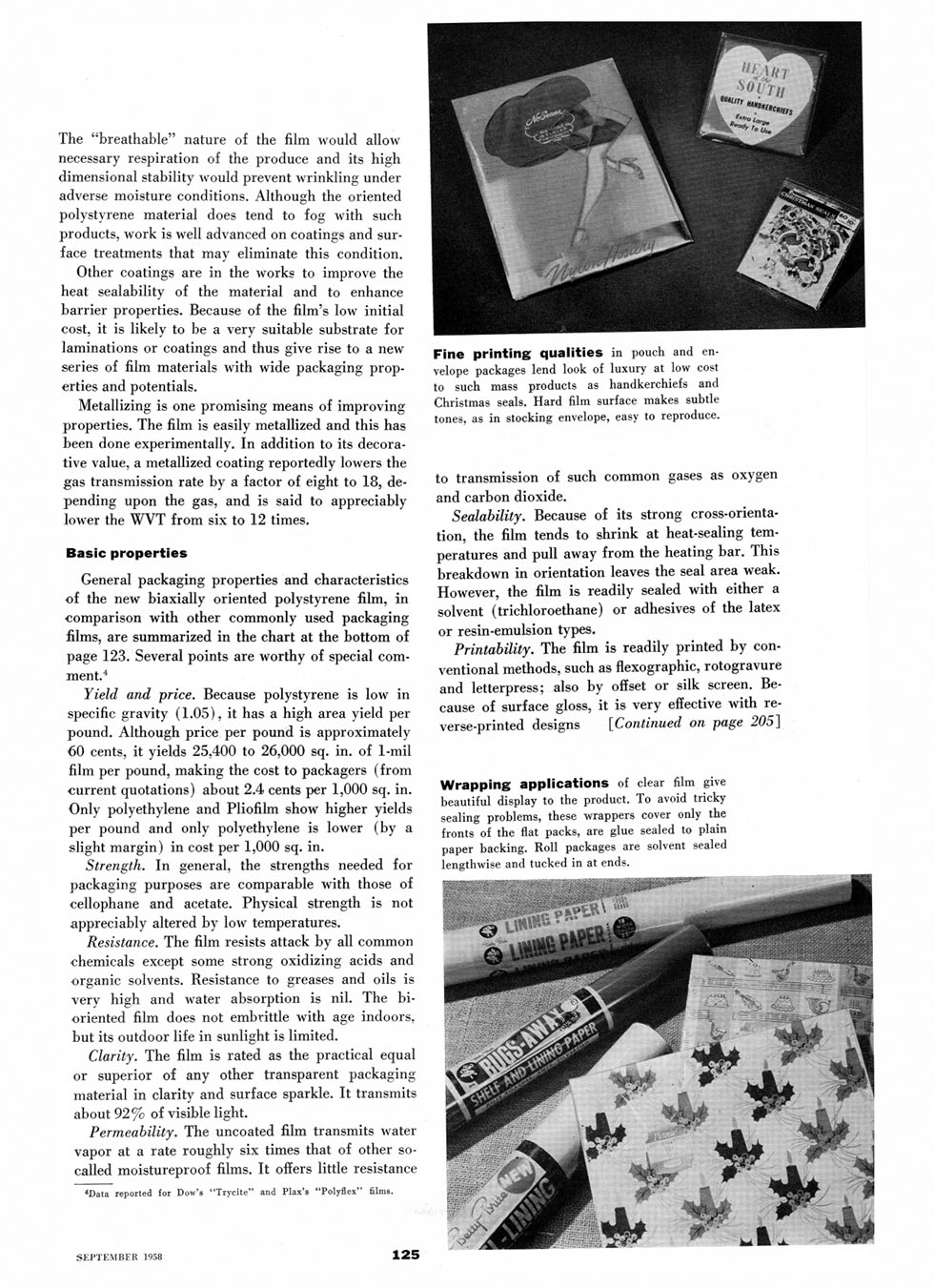


The "breathable"ť nature of the film would allow necessary respiration of the produce and its high dimensional stability would prevent wrinkling under adverse moisture conditions. Although the oriented polystyrene material does tend to fog with such products, work is well advanced on coatings and surface treatments that may eliminate this condition.
Other coatings are in the works to improve the heat sealability of the material and to enhance barrier properties. Because of the film's low initial cost, it is likely to be a very suitable substrate for laminations or coatings and thus give rise to a new series of film materials with wide packaging properties and potentials.
Metallizing is one promising means of improving properties. The film is easily metallized and this has been done experimentally. In addition to its decorative value, a metallized coating reportedly lowers the gas transmission rate by a factor of eight to 18, depending upon the gas, and is said to appreciably lower the WVT from six to 12 times.
Basic properties
General packaging properties and characteristics of the new biaxially oriented polystyrene film, in comparison with other commonly used packaging films, are summarized in the chart at the bottom of page 123. Several points are worthy of special comment.4
Yield and price. Because polystyrene is low in specific gravity (1.05), it has a high area yield per pound. Although price per pound is approximately 60 cents, it yields 25,400 to 26,000 sq. in. of 1-mil film per pound, making the cost to packagers (from current quotations) about 2.4 cents per 1,000 sq. in. Only polyethylene and Pliofilm show higher yields per pound and only polyethylene is lower (by a slight margin) in cost per 1,000 sq. in.
Strength. In general, the strengths needed for packaging purposes are comparable with those of cellophane and acetate. Physical strength is not appreciably altered by low temperatures.
Resistance. The film resists attack by all common chemicals except some strong oxidizing acids and organic solvents. Resistance to greases and oils is very high and water absorption is nil. The bi-oriented film does not embrittle with age indoors, but its outdoor life in sunlight is limited.
Clarity. The film is rated as the practical equal or superior of any other transparent packaging material in clarity and surface sparkle. It transmits about 92% of visible light.
Permeability. The uncoated film transmits water vapor at a rate roughly six times that of other so-called moistureproof films. It offers little resistance
4Data reported for Dow's "Trycite"ť and Plax's "Polyflex"ť films.
Fine printing qualities in pouch and envelope packages lend look of luxury at low cost to such mass products as handkerchiefs and Christmas seals. Hard film surface makes subtle tones, as in stocking envelope, easy to reproduce.
to transmission of such common gases as oxygen and carbon dioxide.
Sealability. Because of its strong cross-orientation, the film tends to shrink at heat-sealing temperatures and pull away from the heating bar. This breakdown in orientation leaves the seal area weak. However, the film is readily sealed with either a solvent (trichloroethane) or adhesives of the latex or resin-emulsion types.
Printability. The film is readily printed by conventional methods, such as flexographic, rotogravure and letterpress; also by offset or silk screen. Because of surface gloss, it is very effective with re-verse-printed designs [Continued on page 205]
Wrapping applications of clear film give beautiful display to the product. To avoid tricky sealing problems, these wrappers cover only the fronts of the flat packs, are glue sealed to plain paper backing. Roll packages are solvent sealed lengthwise and tucked in at ends.